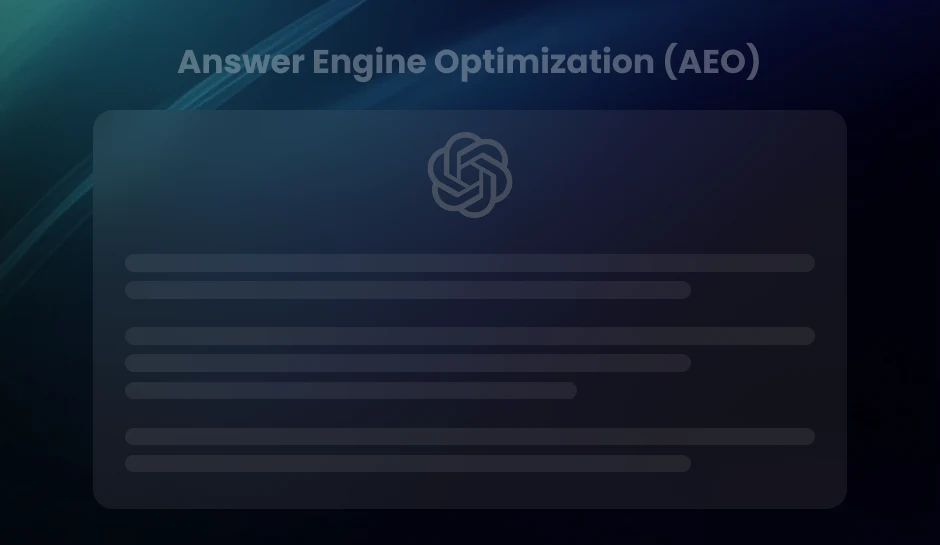
Improving Account-Based Marketing ROI With Data-Driven Campaigns
If your Account-Based Marketing (ABM) strategy isn’t delivering the returns you expect, it's time to reconsider your approach. In this article, you’ll learn how data-driven campaigns can pinpoint inefficiencies, align your teams, and help you achieve a stronger ROI. Whether you’re refining target accounts or optimizing messaging, the insights here will guide you to measurable growth.
You Are Targeting the Right Accounts, But Is the ROI There?
You are seeing engagement. Key accounts are opening emails, attending webinars, maybe even booking demos. But the big question remains: are those efforts turning into revenue?
If you are not sure, you are not alone. Many teams assume that hitting the right accounts means the ROI will follow. But without clear data connecting activity to outcomes, it is easy to overestimate impact or miss key gaps in your strategy.
That is where a data-driven approach makes the difference. When you track what actually moves accounts through the pipeline and what does not, you can focus your efforts, optimize your spend, and finally prove the return on your ABM investment.
In this blog, you will learn how to improve your Account-Based Marketing ROI by using data to guide decisions, measure success, and unlock real business growth.
Why ABM Needs a Data-Driven Approach
“As more than 79% of marketers report higher ROI from ABM than any other marketing effort, it’s clear that ABM can be an effective strategy for almost any B2B company or business with long sales cycles. With the right approach, ABM can work for a company of any size — from enterprises to small and midsize businesses — across every industry.” — Salesforce
It is easy to assume your ABM strategy is solid just because your target accounts are well-defined and your campaigns are running. But when the numbers do not add up, the issue often lies in what you are not seeing, not in what you are doing.
You might be tracking engagement, monitoring campaign performance, and aligning with sales. Still, if your decisions are not rooted in the right data, you are likely missing key opportunities or wasting resources on the wrong actions.
The real power of data-driven ABM is not just in better measurement. It is in revealing the gaps, inefficiencies, and untapped signals that traditional approaches overlook.
Many teams miss ROI because they:
- Rely on broad marketing data instead of account-level insight.
- Fail to capture buying signals early in the journey.
- Over-personalize content without validating what resonates.
- Focus on volume of engagement instead of the quality behind it.
What makes the difference is knowing exactly what to measure, when to act, and where to adjust, and that clarity only comes from the right data foundation.
The Hidden Factors That Distort ABM ROI
Here are the often-overlooked elements that quietly impact your return on ABM investment:
- Engagement Without Intent:
- Fragmented Data Systems:
- Overemphasis on Lead Scores:
- Lagging Indicators:
- Sales and Marketing Misalignment on Metrics:
Accounts may appear active, but without buying intent, those signals are misleading.
When platforms do not integrate, your view of the account journey becomes incomplete.
Scoring models often favor individual leads instead of buying committees, creating false positives.
By the time you see pipeline data, the opportunity to influence decisions may be gone.
If both teams are tracking success differently, ROI will always appear inconsistent.
Building a Strong Data Foundation
If you are running Account-Based Marketing without a solid data foundation, you are almost guaranteed to lose ROI. Not because your strategy is wrong, but because your decisions are built on incomplete, outdated, or disconnected insights.
A strong data foundation is not about collecting everything. It is about collecting the right data, using it to prioritize accounts intelligently, and turning insight into action.
What Actually Moves the Needle
To improve ABM ROI, you need data that helps you answer three critical questions:
- Which accounts are worth your time right now? This is where intent and engagement data are key. If you are treating all target accounts equally, you are likely to overspend on low-interest accounts and miss warm ones.
- What message will resonate at the right stage? Without clear engagement trends or firmographic context, your content may be well-written but completely mistimed.
- Where is spending being wasted? If your data is not unified, you will not see duplicate efforts across teams or channels. That led to higher costs and missed attribution.
The difference between a high-performing campaign and a resource drain often comes down to how well you can connect these data points across platforms.
The Most Overlooked Drivers of ROI Loss
Here are some silent ROI killers you should fix first:
- Rely on Buying Signals, Not Vanity Metrics
- Ensure Seamless Integration Between Marketing and Sales
- Keep Target Account Lists Updated and Validated
- Gather Insights from Customer-Facing Teams
- Build a Clean, Unified Data Layer
The fix is not more tools. It is building a clean, connected data layer that all teams trust and use consistently.
Pro Tip- Want a quick ROI boost? Start by validating your current target account list using recent intent and engagement data. Then map that against closed-won data from your CRM. If there is a gap between who is engaging and who is buying, your data foundation needs attention, and your campaign priorities need to shift.
Aligning Sales and Marketing for Revenue Impact
Having the right data and targeting the right accounts are critical steps in Account-Based Marketing. However, if your sales and marketing teams are not working as one, your ROI will not reflect the full potential of your efforts. In many organizations, the gap between these teams is where revenue is lost, campaigns stall, and opportunities fall through the cracks.
When the two teams operate with different metrics, disconnected systems, or separate priorities, you get delayed responses, inconsistent messaging, and an incomplete picture of the customer journey. This misalignment leads to duplicated effort, wasted spend, and missed revenue targets.
How Alignment Unlocks Growth
To drive meaningful ROI, your sales and marketing teams must operate with a shared strategy, shared data, and shared accountability. Alignment should be built into your workflows, not just your meetings.
- Develop Joint Account Plans: Both teams should work from the same list of high-priority accounts with agreed definitions of success, engagement stages, and ownership.
- Define Unified Metrics: Move away from vanity metrics. Instead, focus on pipeline contribution, deal progression, win rate, and account-level engagement, metrics that both teams can influence.
- Create an Integrated Engagement Timeline: Plan outreach cadences together so that sales and marketing activities support each other, rather than overlap or contradict.
- Use a Shared Platform for Visibility: Tools like DiGGrowth provide a real-time, unified view of each account’s activity across touchpoints. Both teams can access intent signals, engagement data, and previous interactions, making collaboration easier and more effective.
With aligned teams, campaigns are more coordinated, insights are more actionable, and results are far more predictable. This is where ABM moves from activity to actual revenue impact.
Optimizing and Maximizing Account-Based Marketing ROI
Understanding ABM ROI is one thing, but maximizing it is where true growth happens. The key to increasing your ABM ROI lies not only in measuring but in acting on the insights you gather. With the right data foundation, aligned teams, and proper attribution, your next step is to continually refine and optimize your strategy for the best results.
Key Actions to Boost ABM ROI
Refine Target Account Lists Regularly
Use intent data to understand which accounts are actively exploring solutions like yours, and combine that with engagement insights to gauge the level of interest. Collaborate with your sales team to update the list based on recent interactions, feedback, and market changes. By continuously reviewing and updating your target list, you ensure your ABM efforts are always aligned with accounts that have the highest potential for conversion.
Nurture Accounts with Tailored Content
Rather than applying a one-size-fits-all approach, nurture accounts by delivering highly relevant, personalized content that speaks to their unique pain points and challenges at each stage of the buying journey. Use data from previous engagement and firmographic insights to identify what resonates with each account. For instance, a target account in the research phase may benefit from white papers and case studies, while one in the decision stage might respond better to demos or ROI calculators. By tailoring your content, you increase engagement, shorten sales cycles, and improve your chances of moving accounts through the pipeline.
Align Marketing and Sales Actions at Every Stage
To drive consistent results and improve your ABM ROI, align marketing and sales teams at each stage of the account journey. Regular communication between the two ensures that marketing provides the right content and insights, while sales can follow up at the optimal time. Alignment means sharing key metrics and keeping both teams on the same page in terms of messaging, objectives, and follow-up actions. For example, when sales teams notice a specific account showing interest in a particular feature, marketing can quickly adjust content to highlight that feature, boosting the chances of conversion.
Leverage Account Insights to Improve Messaging
Leverage the wealth of data you have on each account to constantly refine and improve your messaging. Whether it is through account engagement data (such as email opens, webinar participation, and content downloads) or insights from customer-facing teams like sales and customer success, use this information to fine-tune your outreach. Understand which types of content and messaging have worked for similar accounts in the past and apply these learnings to create highly targeted, personalized communication. As your account knowledge deepens, you can increase your relevance and enhance engagement, leading to higher conversion rates.
Maximize Your Tech Stack
The power of your ABM strategy is significantly influenced by the tools and platforms you use. To maximize your tech stack, ensure that all your systems are integrated seamlessly. By connecting your CRM, ABM platforms, analytics tools, and other data sources, you can gain a comprehensive view of each account’s journey. This integration not only streamlines workflows but also enhances data accuracy and consistency across teams. A unified tech stack helps uncover hidden opportunities, spot inefficiencies, and automate repetitive tasks, freeing up your team to focus on higher-value activities.
Use Predictive Analytics for Better Forecasting
To improve your ABM ROI and allocate resources more effectively, use predictive analytics to forecast which accounts are most likely to convert. By analyzing historical data and identifying patterns in buyer behavior, predictive tools can help you prioritize accounts that are showing signals of intent or engagement. This allows you to focus your resources on high-potential accounts, rather than spreading efforts too thin across your target list. Additionally, predictive analytics can help you forecast sales cycles, providing insights into when accounts are likely to decide, which can further optimize your outreach strategy.
Key Takeaways
- Focus on capturing intent signals, not just engagement, to improve the accuracy of your ABM efforts.
- A unified data foundation is essential for making informed, strategic decisions that drive real ROI.
- Alignment between sales and marketing is crucial for reducing inefficiencies and ensuring consistent messaging.
- Regularly update your target account list with validated, intent-driven insights to keep your ABM strategy on track.
- Leverage predictive analytics to forecast which accounts are most likely to convert, allowing you to allocate resources effectively.
Conclusion
The key to improving ROI lies in understanding your data, aligning your teams, and continually optimizing your efforts based on what actually drives success. It’s not enough to just target the right accounts or generate engagement, connecting the dots between activity and outcomes is where the real growth happens.
At DiGGrowth, we provide tailored solutions that bridge the gap between your marketing efforts and real, measurable revenue. Our platform allows you to unify data across sales and marketing, streamline your processes, and drive meaningful insights that fuel smarter decisions and faster conversions. We don’t just talk about success; we deliver it through precise, actionable data that empowers your team to make the right moves at the right time.
Get in touch today to start driving measurable, sustainable success with DiGGrowth.
Reach our experts at info@diggrowth.com to explore how we can help you optimize your ABM strategy.
Sources/Citations
Account-Based Marketing (ABM) Guide | Salesforce India | Salesforce India
Ready to get started?
Increase your marketing ROI by 30% with custom dashboards & reports that present a clear picture of marketing effectiveness
Start Free Trial
Experience Premium Marketing Analytics At Budget-Friendly Pricing.

Learn how you can accurately measure return on marketing investment.
Additional Resources
Don’t Let AI Break Your Brand: What Every CMO Should Know
AI isn’t just another marketing tool. It’s changing...
Read full post postFrom Demos to Deployment: Why MCP Is the Foundation of Agentic AI
A quiet revolution is unfolding in AI. And...
Read full post postAnswer Engine Optimization (AEO): The New Frontier of SEO in 2025
As digital experiences continue to evolve, so does...
Read full post postFAQ's
Mapping the buyer journey helps identify key touchpoints where targeted actions can influence decisions. It ensures marketing and sales engage accounts with relevant content at the right time, improving conversion rates and overall ROI.
Key tools include CRM systems, ABM platforms, predictive analytics tools, and data integration software. These enable seamless collaboration, accurate data flow, and better insights into account behavior, ensuring optimized targeting and decision-making.
ABM strategies should be reviewed quarterly. This ensures that targeting, messaging, and data systems stay aligned with evolving buyer behavior, market trends, and pipeline performance, helping you stay agile and improve ROI consistently.
Small teams can improve ROI by focusing on high-quality data, close collaboration between sales and marketing, and prioritising accounts based on intent signals. Clear processes and shared goals often deliver more impact than complex tech stacks alone.
Focus on account progression, pipeline contribution, and overall engagement rather than just leads. Track the full buyer journey, measuring metrics like deal size, win rate, and the quality of interactions at each stage.


